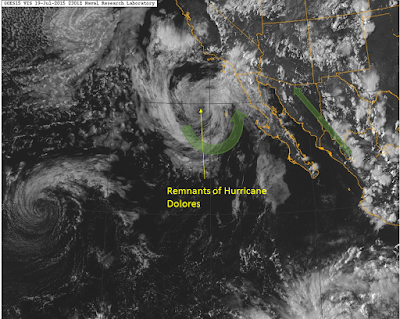T.S. Joaquin became 10th named storm of the season late last night, developing from a depression that formed between the Bahamas and Bermuda on Sunday. Joaquin sits about 405 miles northeast of the Bahamas as of Tuesday evening.
Currently, a healthy cold front is crossing through the middle of the country accompanied by a large rain shield.
 |
| Surface map and radar at 8:00 p.m. EDT September 29. |
 |
| Forecast 500 millibar map for Friday, October 2 at 8:00 a.m. EDT. |
 |
| Forecast positions for Tropical Storm Joaquin issued at 5:00 p.m. EDT September 29 |
So, we have a stalled upper level trough over the eastern U.S., a stationary front off the east coast at the surface, and an approaching tropical storm. All of this adds up to a potential significant heavy rain event along and east of the Appalachians from North Carolina into the Canadian Maritimes.
While Joaquin is not expected to make landfall, the counterclockwise circulation around the storm will be feeding moisture from the Atlantic west across the stationary front. That, combined with the stalled trough aloft tapping moisture from the Gulf of Mexico, will likely result in prolonged and heavy rain along the eastern seaboard. Forecast models are currently indicate that in excess of six inches of rain could accumulate by early next week.
A series of low pressure waves moving along the front on Wednesday and into Friday will produce the heaviest rain in the northeast and New England. Then the focus shifts to the mid-Atlantic region as moisture associated with T.S. Joaquin interacts with the stalled frontal boundary. Joaquin is expected to be eventually absorbed by the main trough aloft and will be reflected as another low pressure wave along the front. That combination will bring rain to the Northeast and New England through this weekend before high pressure takes over on Tuesday.
 |
| Quantitative Precipitation Forecasts for the three-day period ending 8:00 p.m. EDT Friday, October 2 (left), and the two-day forecast for the period ending 8:00 p.m. EDT Sunday, October 4 (right). |
 |
| Quantitative Precipitation Forecast for the 7-day period ending 8:00 p.m. EDT Tuesday, October 6. |
Flood watches are already in place from the central Appalachians through New England through Wednesday. There is still is uncertainty in the how this situation will play out, so be sure to stay abreast of the latest forecasts and advisories if you are in any of the areas to be affected by this system.















































